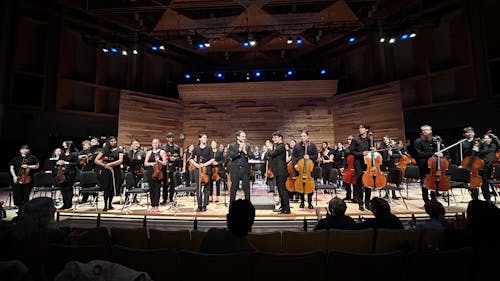Rutgers Sinfonia gives perfect performance, no notes

Last Friday, folks gathered at the Nicholas Music Center on Douglass Campus, the largest performance stage on campus, to witness Rutgers Sinfonia's Spring 2024 semester show.
The symphony performs once every semester, consistently delivering timeless programs for more than 20 years. What's exciting about the Sinfonia is that musicians can be from any Rutgers school, not just Mason Gross School of the Arts.
This concert was musically directed by Ching-Chun Lai, the director of orchestral activities and an associate professor at Mason Gross. Having taught and conducted with professional orchestras from all over the world, she made sure the program ran smoothly and offered valuable insights to aspiring Rutgers musicians.
Accompanying Lai were rising conductors Christopher Beckett, Tomás García and Nathan Sawyer, all of whom are pursuing a higher musical education under the instruction of Lai.
With a start time of 7:30 p.m., the show was divided into two acts with an intermission between playtime. Beckett was the conductor of the first five songs while García and Sawyer co-directed the Sinfonia in the following four songs.
The most interesting thing about orchestral songs is how universal they are. Although the titles of the musical numbers may seem intimidating, the pieces instantly became recognizable only a few notes in.
For example, the second song in the program, "Morning Mood" by Edvard Grieg, blanketed listeners with a warm and familiar feeling. It evoked strong nostalgic emotions and led the mind through a self-contained journey.
Some outstanding moments featured the sound of atypical orchestra instruments such as harps and chimes floating through the melodies. The whimsical sounds complimented by percussion or horns and anchored by the ever-present strings kept the audience engaged.
In addition to the more unique sounds, the infrequent solos of the basses were extraordinary, mostly due to the instrument's uncanny ability to yield a physical reaction — the rich sounds were simply hair-raising.
The notes felt as if they were traveling through the body, starting from the crown of the head and flowing to the soles of the feet. The sounds were unexpectedly successful in creating a multisensory experience.
Outside of being aurally mesmerizing, the show was visibly striking — the synchronicity of the all-black attire was eye-catching. The colors of the instruments contrasting the glimmer of the horns and the wood of the stage was also charming.
The Sinfonia commanded the audience to be present, creating an incredibly conscious experience. An apt phrase to describe the 90-minute event was sensorial harmony — it was all-around compelling and impressive.
While not nearly as captivating as the in-person experience, the performance was also streamed live for music fans.
But, for enthusiasts looking for a musical, out-of-body experience, consider heading down to Nicholas Music Center in the Fall 2024 semester when the Sinfonia returns with another mesmerizing performance.



